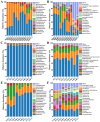Industrial-Scale Bioconversion of Three-Phase Residue by Musca domestica Larvae: Dynamics of Gut Microbiota and Their Ecological Driver
- PMID: 40725315
- PMCID: PMC12295176
- DOI: 10.3390/insects16070686
Industrial-Scale Bioconversion of Three-Phase Residue by Musca domestica Larvae: Dynamics of Gut Microbiota and Their Ecological Driver
Abstract
The escalating global population coupled with rising living standards in developing nations has created dual challenges in sustainable food production and organic waste management [...].
Keywords: Musca domestica; feed–gut–frass continuum; lactic acid bacteria (LAB); microbial community; three-phase residue (TPR).
Conflict of interest statement
The authors declare no conflicts of interest.
Figures






Similar articles
-
Efficacy of Hot Capsicum annuum Extracts Against the Biological Activity of Culex pipiens and Musca domestica Larvae with their Phytochemical Profiles.Acta Parasitol. 2025 Jun 9;70(3):129. doi: 10.1007/s11686-025-01066-3. Acta Parasitol. 2025. PMID: 40488911
-
An Insight into Microbial Inoculants for Bioconversion of Waste Biomass into Sustainable "Bio-Organic" Fertilizers: A Bibliometric Analysis and Systematic Literature Review.Int J Mol Sci. 2022 Oct 27;23(21):13049. doi: 10.3390/ijms232113049. Int J Mol Sci. 2022. PMID: 36361844 Free PMC article.
-
Sustainable Biotransformation of Food Waste into Biogas Via Microbial Anaerobic Digestion: A Review.Indian J Microbiol. 2025 Jun;65(2):697-712. doi: 10.1007/s12088-025-01463-2. Epub 2025 Mar 11. Indian J Microbiol. 2025. PMID: 40655391
-
Seasonal variation effect on different Physalis peruviana L. (Solanaceae) waste extracts and investigation of their efficacy against Culex pipiens and Musca domestica.Sci Rep. 2025 Jun 20;15(1):20231. doi: 10.1038/s41598-025-89854-9. Sci Rep. 2025. PMID: 40542175 Free PMC article.
-
Evolving Dynamics of Fermented Food Microbiota and the Gut Microenvironment: Strategic Pathways to Enhance Human Health.Foods. 2025 Jul 3;14(13):2361. doi: 10.3390/foods14132361. Foods. 2025. PMID: 40647113 Free PMC article. Review.
References
-
- Salomone R., Saija G., Mondello G., Giannetto A., Fasulo S., Savastano D. Environmental Impact of Food Waste Bioconversion by Insects: Application of Life Cycle Assessment to Process Using Hermetia Illucens. J. Clean. Prod. 2017;140:890–905. doi: 10.1016/j.jclepro.2016.06.154. - DOI
-
- Van Huis A., Dicke M., Van Loon J.J.A. Insects to Feed the World. JIFF. 2015;1:3–5. doi: 10.3920/JIFF2015.x002. - DOI
Grants and funding
LinkOut - more resources
Full Text Sources
Miscellaneous

